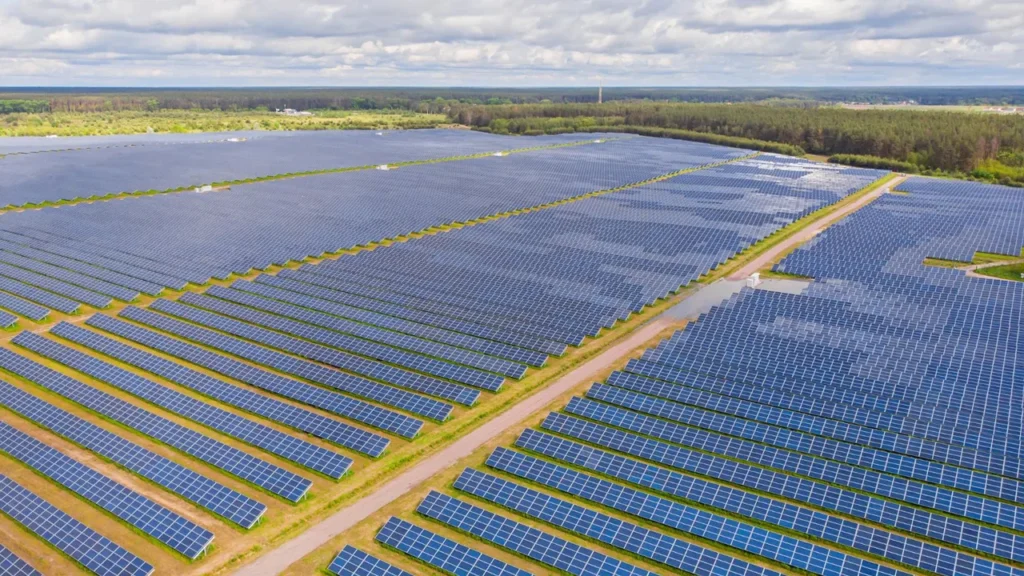As global demand for clean and sustainable energy accelerates, innovative technologies continue to reshape the renewable landscape. One of the fastest-growing breakthroughs is floating solar—a water-based photovoltaic system designed to maximize efficiency while reducing land usage. Installed on lakes, reservoirs, and hydropower dams, floating solar platforms expand solar energy capacity without competing with agricultural, industrial, or residential land. As part of modern renewable hybrid systems, they offer a compelling alternative for countries seeking scalable and environmentally adaptive solutions.
Introduction to Floating Solar Systems
Floating solar, also known as floating photovoltaic (FPV), represents a strategic evolution of land-based solar farms. Instead of occupying large tracts of land, the panels are mounted on buoyant structures that float on calm water surfaces. The concept emerged from the desire to save land resources, reduce evaporation, and improve panel efficiency through natural water cooling. With utility-scale deployment gaining momentum, floating solar has become a global symbol of innovation in renewable hybrid systems.
Floating solar systems are particularly effective in regions where land availability is limited or expensive. Water reservoirs, dams, mining pits, and industrial water bodies present massive untapped potential—making the technology ideal for both developed and emerging markets.
How Floating Solar Farms Work
Core Components of a Floating Solar System
A typical floating solar installation integrates several engineered components that work together to ensure long-term stability and performance:
- Buoyant Floating Platforms: Typically made from durable HDPE pontoons, designed to support panels, walkways, and maintenance crews.
- Photovoltaic Panels: High-efficiency solar modules mounted at optimal angles to maximize sunlight exposure.
- Mooring & Anchoring Systems: Customized to withstand water movement, wind pressure, and seasonal fluctuations.
- Electrical Infrastructure: Waterproof connectors, submersible cables, and inverters that transform DC into usable AC power.
The Role of Hydropower Integration
One of the strongest advantages of floating solar emerges when combined with existing hydropower reservoirs. Water-based solar arrays can generate electricity during daylight hours, while hydropower compensates during low-sunlight periods. This dynamic synergy creates highly stable renewable hybrid systems, improving energy output and grid reliability.
- Hydropower dams already have grid connections, reducing infrastructure cost.
- Reservoirs provide vast open water surfaces suitable for solar deployment.
- Seasonal changes between solar and hydro can balance energy peaks.
Site Selection & Water Requirements
Designing a floating solar farm starts with choosing the right location. Lakes, artificial reservoirs, irrigation ponds, and quarry lakes are the most common options. Engineers consider depth, water movement, environmental protection zones, and weather patterns to ensure long-term stability.
Key Advantages of Floating Solar Farms
Higher Energy Output
Floating solar panels operate more efficiently than ground-mounted panels due to water cooling. The natural temperature regulation reduces heat stress on panels, boosting power output by up to 10–15% in many climates. Less thermal expansion also translates to longer module lifespan.
Large-Scale Deployment Without Land Conflicts
Floating solar solves one of the biggest challenges in renewable expansion—land scarcity. Since systems are installed on unused water surfaces, they avoid conflicts with agriculture, housing development, and environmental conservation. This makes floating solar especially attractive for countries with dense populations and high land value.
Compatibility With Renewable Hybrid Systems
Floating solar’s ability to integrate seamlessly with hydropower, wind, or energy storage technologies creates advanced renewable hybrid systems. These combinations result in:
- More stable energy output.
- Reduced dependency on fossil backup systems.
- Improved national grid resilience.
Challenges and Engineering Considerations
Structural Design Challenges
Despite its benefits, floating solar requires robust engineering to handle water dynamics. Wave action, fluctuating water levels, and strong winds pose structural risks. Engineers use advanced simulations, anchoring strategies, and durable materials to ensure that floating solar installations perform reliably for decades.
Environmental & Ecological Concerns
Floating solar installations must balance energy production with ecological protection. Key environmental considerations include:
- Preventing excessive shading that could affect aquatic ecosystems.
- Avoiding harm to fish habitats and water quality.
- Ensuring materials are non-toxic and resistant to long-term environmental exposure.
Maintenance, Safety & Risk Reduction
Water-based PV systems require specialized safety planning, including waterproof electrical components, grounding precautions, and pathways for emergency access. Storm resilience and fire prevention strategies are incorporated during the design phase to ensure operational security.
Applications of Floating Solar Around the World

Asia-Pacific Leading the Market
The Asia-Pacific region dominates the expansion of floating solar, with China, India, South Korea, and Singapore deploying large-scale systems. Reservoir-based installations in China exceed hundreds of megawatts, demonstrating the viability of mega-scale FPV technology.
Europe’s Push for Sustainable Energy Transition
European nations such as the Netherlands and Portugal are rapidly adopting floating solar to support energy transition initiatives. Smaller land availability and strict environmental policies make water-based systems an effective choice.
Emerging Markets Using Renewable Hybrid Systems
Africa, Southeast Asia, and Latin America are exploring floating solar to complement hydroelectric plants and reduce dependence on diesel generators—creating cost-efficient renewable hybrid systems tailored for rural electrification.
Technical Engineering Breakdown
Floatation System Engineering
Every floating solar farm depends on a highly engineered buoyancy system capable of supporting the weight of panels, inverters, walkways, and technicians. Most systems use modular HDPE floats designed to withstand UV radiation, corrosion, and long-term exposure to varying water conditions. Engineers conduct buoyancy calculations, stress analysis, and stability modeling to ensure the floating platform remains secure and balanced under fluctuating environmental loads.
Anchoring & Mooring Design
Anchoring systems play a critical role in stabilizing floating solar arrays. Depending on water depth and site conditions, anchoring may involve:
- Bank anchoring for shallow reservoirs
- Floor anchoring using concrete blocks or driven piles
- Mooring lines designed to absorb wave and wind forces
The design must manage water-level variations, storm events, and rotational loads. High-quality mooring components are essential to maintain the system’s positioning and ensure long-term performance.
Electrical Integration & Cable Protection
Water environments demand strict electrical safety. All connectors, wiring conduits, and junction boxes used in floating solar systems must meet waterproofing standards such as IP67 or IP68. Submerged or semi-submerged cables require abrasion resistance and careful routing to prevent tension or fatigue. Specialized floating walkways allow technicians to safely access electrical components, while transformers and inverters are typically installed on dedicated floating platforms or nearby onshore stations.
Economic & Operational Benefits
Capex vs Opex Considerations
The financial attractiveness of floating solar has accelerated in recent years due to falling PV prices, improved floating materials, and large-scale manufacturing efficiencies. Capital expenditure (Capex) includes floatation systems, anchoring infrastructure, panel installation, and electrical integration. Operational expenditure (Opex) is generally low because floating solar systems require minimal cleaning—water cooling reduces dust accumulation and improves panel longevity.
Lifecycle & Durability
Modern floating solar installations boast a typical lifespan of 25–30 years. HDPE floats, galvanized steel supports, and corrosion-resistant structural components ensure reliability even in harsh climates. With proper maintenance and periodic inspection, floating solar systems deliver sustainable energy across their entire lifecycle, further strengthening their role in future renewable hybrid systems.
Government Support & Incentives
Many countries actively encourage floating solar development through renewable energy policies, feed-in tariffs, investment subsidies, and grid-integration support. These incentives help accelerate deployment and reduce financial barriers, especially in markets with high energy demand or limited land availability.
Future Trends in Floating Solar Technology
AI + IoT Monitoring Systems
The future of floating solar is closely tied to digital innovation. AI-driven monitoring systems can predict energy output, detect anomalies, and optimize performance. IoT sensors track temperature, water movement, and structural stress, providing actionable insights that reduce operational risks.
Floating Solar + Aquaculture Integration
Dual-use water systems are gaining momentum, where floating solar platforms coexist with aquaculture. This integration reduces water evaporation, provides partial shading for fish farms, and creates an efficient multi-purpose water ecosystem.
The Rise of Mega-Scale Floating Solar Projects
Countries worldwide are planning or developing gigawatt-scale floating solar farms. These mega projects combine FPV with pumped-storage hydropower and battery systems to create resilient renewable hybrid systems capable of supporting national grids.
Conclusion
Floating solar represents the next evolution in renewable energy engineering. By utilizing unused water surfaces, reducing land pressure, and offering higher efficiency through natural cooling, floating solar systems are reshaping global clean-energy strategies. Their compatibility with hydropower and other renewable hybrid systems further strengthens energy resilience and makes them an essential component for the future of sustainable electricity generation. As technology improves and project scales continue to increase, floating solar is set to become one of the world’s most influential renewable solutions.



